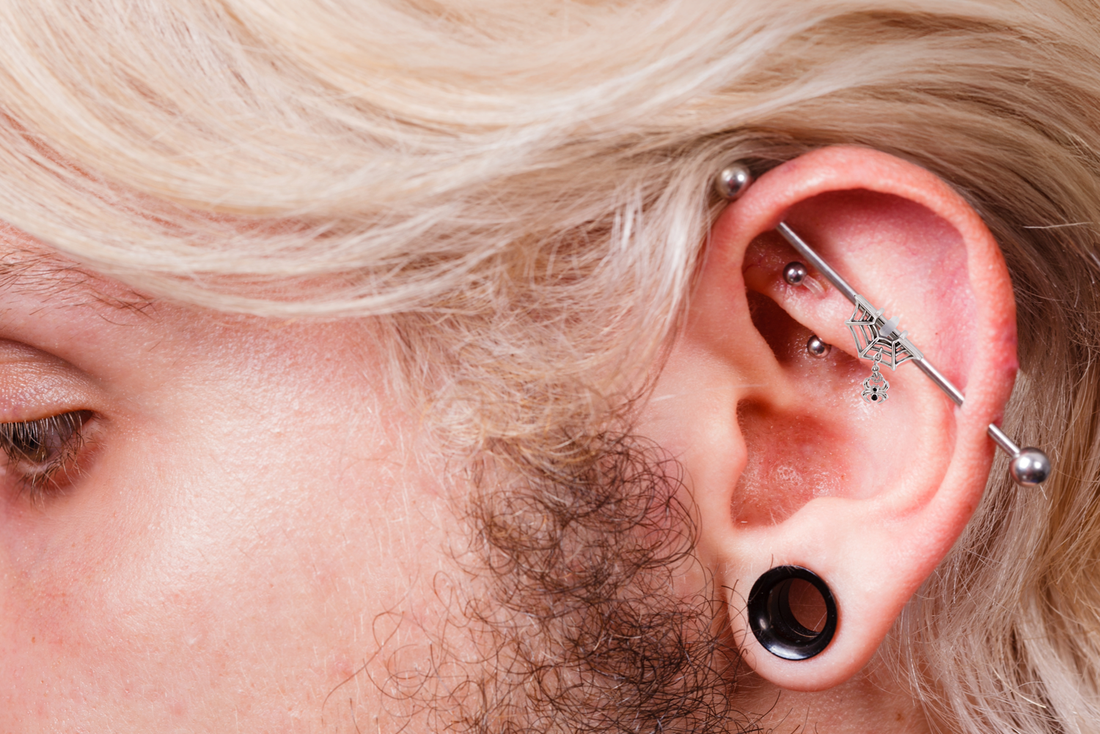1. Introduction
When it comes to making a bold style statement, an industrial piercing is a top choice for those who want to stand out. At Pierced Addiction, we have been a trusted online retailer for over 20 years, specializing in high-quality body jewelry crafted from premium materials like ASTM F-136 titanium and 18K gold. Our mission is to provide stylish, safe, and long-lasting jewelry options that cater to your personal style and comfort.
In this blog post, we will guide you through every aspect of industrial piercings—from what they are and how they’re done, to the pain you might experience, how long it takes to heal, the best jewelry options, and essential aftercare tips. Whether you're considering your first piercing or looking to upgrade your current style, this post will help you make an informed decision.

14G Moon With Snowflakes Industrial Barbell
2. What is an Industrial Piercing?
An industrial piercing, also known as a scaffold or construction piercing, is a unique type of ear piercing that involves two holes connected by a single straight barbell. Here’s what you need to know about this standout style:
- Double Cartilage Piercing: Unlike a standard lobe piercing, an industrial piercing involves two separate entry points in the cartilage. These two points are connected with a barbell, creating a visually striking design.
- Placement: Typically, industrial piercings are placed on the upper ear cartilage, often at an angle that complements the natural curve of your ear.
- Alternative Names: You might hear it referred to as a “scaffold piercing” or “construction piercing” due to its structural appearance.
This style is popular not only because of its edgy look but also because it offers a level of versatility in design and customization. With a range of jewelry options available, you can personalize your industrial piercing to match your personality and style.

14G Industrial Barbell - Skeleton Hand Heart
3. How Painful is an Industrial Piercing?
One of the first questions you might have is about the pain level involved in getting an industrial piercing. Here’s a breakdown:
-
Moderate to High Pain: Because industrial piercings involve cartilage—one of the tougher and less forgiving parts of the ear—the pain level can be moderate to high. Most people report feeling a strong pinch during the piercing process followed by a throbbing or pulsating sensation.
-
Factors That Affect Pain:
- Personal Pain Tolerance: Everyone experiences pain differently. What may feel moderate to one person might be intense for another.
- Skill of the Piercer: An experienced professional can make the process smoother and more precise, often reducing the overall discomfort.
- Cartilage Thickness: The thickness and density of your cartilage can also influence the pain level. Thicker cartilage may require a bit more force, leading to a more intense experience.
Compared to other types of ear piercings—such as lobe piercings, which are generally less painful due to the softer tissue—industrial piercings are known to be on the higher end of the pain spectrum. However, many people find that the initial discomfort is temporary, and the resulting style is well worth it.

4. Healing Time & What to Expect
Understanding the healing process is essential when deciding on an industrial piercing. Here’s what you can expect:
- Healing Duration: On average, an industrial piercing takes about 6-12 months to fully heal. This is significantly longer than lobe piercings, which often heal within a few weeks.
- Initial Aftercare: The first few weeks can be challenging. You might experience swelling, tenderness, and some discomfort as your body begins to heal.
- Potential Issues During Healing:
-
-
Irritation Bumps: These can occur due to movement, pressure, or improper cleaning. It’s important to treat these promptly to avoid further irritation.
-
Migration or Rejection: Without proper aftercare, there’s a risk that your body might push the jewelry out or that the piercing might not settle well.
-
During the healing period, it is crucial to maintain a regular cleaning routine and avoid activities that put excessive pressure on your ears. Keeping up with aftercare is the key to ensuring a smooth and trouble-free healing process.
5. Best Jewelry for Industrial Piercings
Choosing the right jewelry is not only about aesthetics—it’s also a matter of safety and comfort. Here’s a look at the top choices for industrial piercings:
- Straight Barbells: The most common and traditional option for industrial piercings, straight barbells are designed to fit comfortably between the two piercing sites.
- ASTM F-136 Titanium: This high-grade titanium is hypoallergenic, lightweight, and corrosion-resistant, making it an excellent choice for those with sensitive skin.
- 18K Gold: For a touch of luxury and style, 18K gold industrial barbells provide both elegance and safety once your piercing is fully healed.
- Surgical Steel: While durable and cost-effective, surgical steel may contain traces of nickel. It might not be the best option for people with nickel allergies.
- Custom Barbells: If you’re looking for something unique, custom barbells with gems or specially shaped designs can add a personal touch to your industrial piercing.
When selecting your jewelry, it’s important to consider not only the material and design but also how it will interact with your body as you heal. Quality materials like titanium and 18K gold are often recommended because they minimize the risk of allergic reactions and help maintain a clean, irritation-free piercing.
6. Aftercare Tips for a Smooth Healing Process
Proper aftercare is essential to ensure your industrial piercing heals well and stays healthy. Here are some tried-and-true tips to follow:
- Clean Regularly: Gently clean your piercing twice daily with a saline solution or a sterile wound wash. This helps prevent infection and keeps the area free of debris.
- Avoid Unnecessary Touching: Try not to twist, rotate, or fiddle with your jewelry unless instructed by your piercer. Excess movement can delay healing or cause irritation.
- Watch Your Sleep: Avoid sleeping on the piercing. Consider using a travel pillow or special head support to keep pressure off your ear.
- Keep It Clean: Make sure your hair, hats, and even headphones are kept away from the piercing, especially during the initial healing phase.
- Monitor for Infection: Keep an eye out for signs of infection such as redness, excessive swelling, pain, or pus. If you notice any of these symptoms, consult your healthcare provider promptly.
- Be Patient: Healing takes time. It might be tempting to change your jewelry frequently or touch up the area, but patience is key to avoiding complications.
Incorporating these aftercare practices into your routine can greatly reduce the risk of complications such as irritation bumps, keloids, or even jewelry rejection.
7. Common Industrial Piercing Problems & How to Fix Them
While industrial piercings can be a stunning addition to your look, they can sometimes come with challenges. Here’s how to recognize and address common issues:
Irritation Bumps
- Causes: Irritation bumps are often caused by excessive movement, pressure from heavy or tight jewelry, or improper cleaning.
- Solutions: Use warm sea salt soaks to reduce inflammation, and avoid touching or rotating the jewelry. If the bump persists, consult your piercer for advice on adjusting your aftercare routine.
Keloids vs. Hypertrophic Scars
- Understanding the Difference:
- Keloids are overgrowths of scar tissue that extend beyond the original wound and are often more severe.
- Hypertrophic scars are raised scars that remain confined to the site of the injury.
- Treatment Options: If you notice abnormal scarring, speak with a dermatologist. Treatments might include silicone sheets, corticosteroid injections, or in some cases, minor surgical procedures.
Jewelry Rejection
- What It Is: Jewelry rejection occurs when your body begins to push the jewelry out because it doesn’t recognize it as a permanent part of your body.
- Preventive Measures: Ensure your piercing is done by a professional and that you follow strict aftercare guidelines. If rejection signs appear (such as increased mobility of the jewelry or skin irritation), it might be necessary to change the jewelry or adjust the piercing.
By being aware of these potential issues and knowing how to address them early on, you can ensure that your industrial piercing remains a source of pride rather than discomfort.
8. Why Choose Pierced Addiction for Your Industrial Piercing Jewelry?
With over two decades of experience in the body jewelry industry, Pierced Addiction is your go-to source for premium industrial piercing jewelry. Here’s why:
- Expertise You Can Trust: With 20 years of experience, we have honed our craft to provide jewelry that meets the highest standards of quality and safety.
- High-Quality Materials: Our product range features jewelry made from ASTM F-136 titanium and 18K gold, ensuring that each piece is hypoallergenic, durable, and stylish.
- Customer Satisfaction: We have built a reputation for excellent customer service and are trusted by thousands of satisfied customers. Our commitment to quality and safety is evident in every piece of jewelry we offer.
- Fashion-Forward Designs: Whether you’re after a classic straight barbell or something more custom with gems and unique shapes, our extensive collection is designed to help you express your individual style.
- Easy Shopping Experience: With our user-friendly website, finding the perfect piece for your industrial piercing has never been easier. Explore our collection, read detailed product descriptions, and shop with confidence knowing you’re investing in the best.
Call-to-Action: Ready to upgrade your look with a high-quality industrial piercing? Shop our collection now and experience the difference that comes with expert craftsmanship and premium materials.
9. Conclusion
An industrial piercing is more than just a piercing—it’s a bold statement that combines style, individuality, and a bit of edge. While the process might come with a moderate to high level of pain and a lengthy healing period, the end result is a unique look that can transform your personal style.
By choosing the right jewelry and following proper aftercare protocols, you can minimize risks and enjoy your industrial piercing for years to come. Remember, quality matters—opt for materials like ASTM F-136 titanium and 18K gold to ensure your piercing is safe, comfortable, and looks stunning.
At Pierced Addiction, we are dedicated to offering high-quality industrial piercing jewelry that stands the test of time. Our two decades of experience in the body jewelry industry guarantee that you’re getting products that combine safety, durability, and style. Whether you’re a seasoned piercing enthusiast or considering your first industrial piercing, our expert guidance and extensive product range will help you make the best choice.
Embrace your individuality, take care of your piercing, and let your style shine through. We hope this guide has provided you with all the information you need to confidently decide if an industrial piercing is right for you. For any further questions or personalized advice, feel free to reach out to our expert team.

